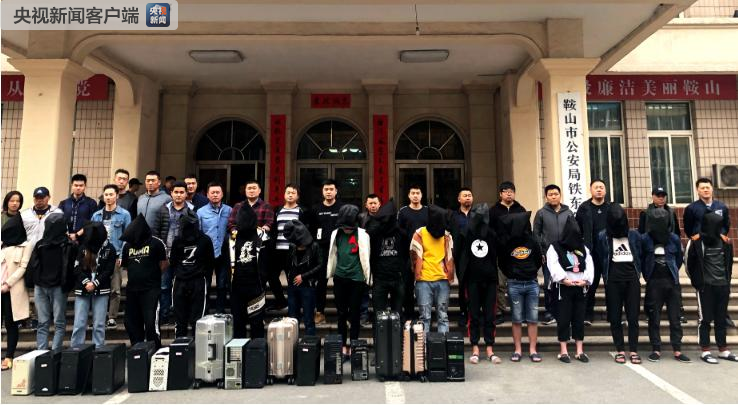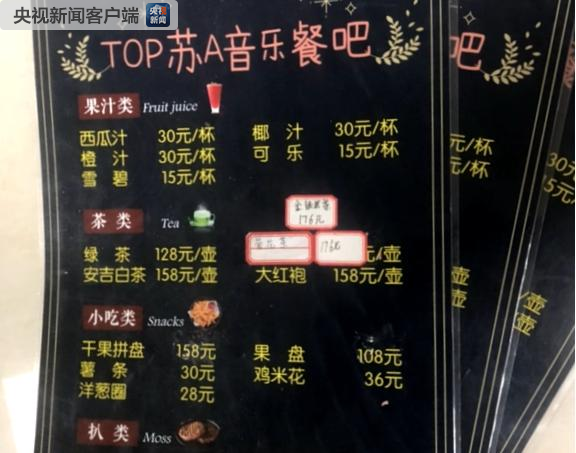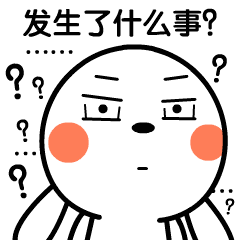Statistical Bulletin on National Economic and Social Development of Jiangsu Province in 2021
Jiangsu province statistics bureau national bureau of statistics Jiangsu survey corps
In 2021, the whole province will adhere to the guidance of Socialism with Chinese characteristics Thought of the Supreme Leader in the New Era, conscientiously implement the decision-making arrangements of the CPC Central Committee and the State Council and the requirements of the provincial party committee and government, adhere to the general tone of striving for progress while maintaining stability, and do a good job in the work of "six stabilities" and "six guarantees", effectively cope with the complicated and changeable external environment and various risk challenges, reach a new level in comprehensive strength, achieve new breakthroughs in structural transformation, demonstrate new advantages in development momentum, and make new progress and high achievements in building a new development pattern.
First, integration
The economic aggregate has leapt to a new level. According to preliminary accounting, the annual GDP reached 11,636.42 billion yuan, reaching a new level of 11 trillion yuan, an increase of 8.6% over the previous year. Among them, the added value of the primary industry was 472.24 billion yuan, an increase of 3.1%; The added value of the secondary industry was 5,177.54 billion yuan, an increase of 10.1%; The added value of the tertiary industry was 5,986.64 billion yuan, an increase of 7.7%. The proportion of three industrial structures in the whole year is 4.1:44.5:51.4. The province’s per capita GDP was 137,039 yuan, an increase of 8.3% over the previous year. The economic vitality was enhanced, and the added value of the non-public sector of the economy reached 8,762.22 billion yuan, accounting for 75.3% of GDP, an increase of 0.4 percentage points over the previous year; The added value of private individual economy accounts for 53.2% of GDP, and the added value of private economy accounts for 57.3% of GDP. At the end of the year, there were 3.574 million private enterprises registered by the industrial and commercial departments, and 640,000 private enterprises were newly registered throughout the year; At the end of the year, there were 9.51 million self-employed households and 1.848 million newly registered self-employed households. The regional economic development is strongly supported. The Yangtze River urban agglomeration contributes 76.9% to the province’s economic growth, and the coastal economic belt contributes 18.1% to the province’s economic growth.
Emerging kinetic energy continues to grow. In the whole year, the output value of industrial strategic emerging industries and high-tech industries accounted for 39.8% and 47.5% respectively, increasing by 3 and 1 percentage point respectively over the previous year. The operating income of the regulated high-tech service industry increased by 18.1% year-on-year, contributing 32% to the growth of the regulated service industry in the province. Investment in high-tech industries increased by 21.6% over the previous year, which was 15.8 percentage points higher than the total investment. Digital empowerment is powerful. The added value of digital products manufacturing industry in gauge industry increased by 19.7% over the previous year, which was 6.9 percentage points higher than that in gauge industry. According to the regulations, the operating income of Internet and related services in the service industry increased by 27.5% over the previous year.
The employment situation remained generally stable. In 2001, 1.402 million new jobs were created in cities and towns, an increase of 74,000 over the previous year and a year-on-year increase of 5.6%. The unemployment rate in urban survey should be controlled within the expected target. Efforts were made to ensure the employment of key groups. The employment rate of college graduates at the end of the year was 95.6%, and 54,000 people with employment difficulties were resettled in newly developed public welfare posts. We promoted the "Creating a Sound in Jiangsu" series of activities, supported 397,000 successful independent entrepreneurs, and the entrepreneurial multiplier effect continued to be released.
Consumer prices rose moderately. The annual consumer price rose by 1.6% over the previous year, including 1.6% in cities and 1.5% in rural areas. By category, food, alcohol and tobacco rose by 0.9%, clothing by 1.5%, residence by 1.3%, daily necessities and services by 1.1%, transportation and communication by 4.3%, education, culture and entertainment by 1.8%, medical care by 1.0% and other supplies and services by 1.1%. Among foods, grain rose by 0.8%, edible oil by 6.3%, fresh vegetables by 6.8%, aquatic products by 14.0%, eggs by 12.5% and livestock meat by 15.0%. The ex-factory price of industrial producers rose by 6.3% over the previous year, and the purchase price of industrial producers rose by 13.8%.

While seeing remarkable achievements in economic and social development, we should also be soberly aware that the current situation of epidemic prevention and control is still grim, the market demand is still weak, the development of some industries, especially small and medium-sized enterprises, is still difficult, and the stability of the industrial chain supply chain is under great pressure. The problem of "sticking the neck" in many key areas is still outstanding, the foundation of independent and controllable modern industrial system is still not solid enough, there are still many shortcomings in people’s livelihood fields such as education, medical care, old-age care and child-rearing, and there are still some potential risks in some areas.
Second, agriculture, forestry, animal husbandry and fishery
The planting structure was continuously optimized. The annual grain planting area was 5.428 million hectares, an increase of 22,000 hectares over the previous year; The cotton planting area was 0.6 million hectares, a decrease of 0.3 million hectares; The oil planting area is 296,000 hectares, an increase of 18,000 hectares; The vegetable planting area was 1.453 million hectares, an increase of 0.9 million hectares. The comprehensive agricultural production capacity continued to increase, and the total grain output reached a new high of 37.461 million tons, an increase of 170,000 tons or 0.5% over the previous year. Among them, summer grain was 13.807 million tons, an increase of 0.5%; Autumn grain was 23.654 million tons, an increase of 0.4%. The grain yield per mu was 460.1 kg, an increase of 0.2 kg or 0.1% over the previous year.
Forestry, animal husbandry and fishery production are generally stable. The annual afforestation area is 11,000 hectares. The annual output of pigs, cattle, sheep and poultry was 3.041 million tons, an increase of 14.6% over the previous year; The output of poultry eggs was 2.303 million tons, down by 0.7%; The total output of milk was 649,000 tons, an increase of 3.1%. The total output of aquatic products was 4.955 million tons (excluding offshore fishing), up by 1.3% over the previous year, including 3.667 million tons of freshwater products and 1.288 million tons of seawater products, up by 3.2% and down by 3.9% respectively.
Modern agriculture has developed rapidly. The province has built 3.9 million mu of high-standard farmland, and the comprehensive mechanization rate of crop cultivation and harvest exceeds 83%, which is nearly 11 percentage points higher than the national average. The province’s effective irrigation area reached 4.232 million hectares, with an additional effective irrigation area of 0.8 million hectares.
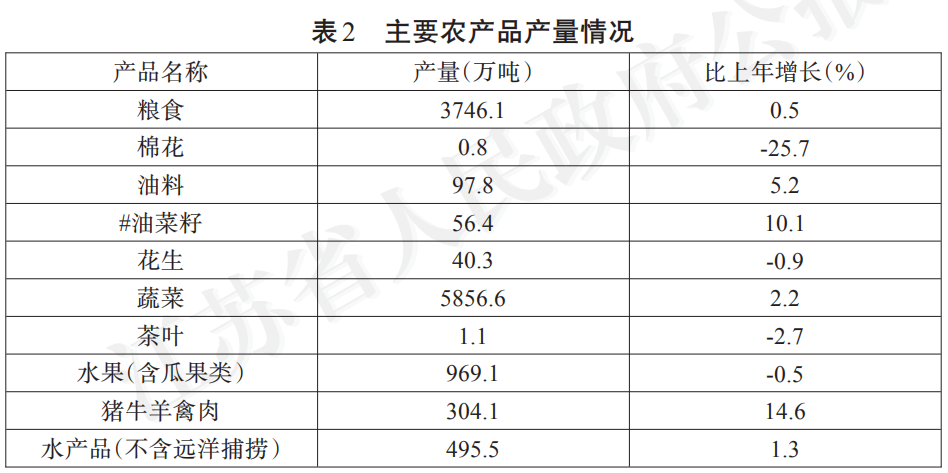
III. Industry and Construction Industry
Industrial production resumed steadily. The added value of industrial enterprises above designated size increased by 12.8% over the previous year, including light industry by 12.4% and heavy industry by 12.9%. In terms of economic types, the added value of state-owned holding enterprises increased by 7.9%, collective enterprises by 8.2%, joint-stock enterprises by 14.4%, foreign-invested enterprises from Hong Kong, Macao and Taiwan by 10.7% and private enterprises by 15.5%. In terms of categories, the mining industry increased by 2.1%, the manufacturing industry increased by 12.8%, and the electricity, heat, gas and water production and supply industries increased by 12.8%.
The advanced manufacturing industry is growing well. The added value of high-tech industry and equipment manufacturing industry in the province increased by 17.1% and 17.0% respectively over the previous year, which was 4.3 and 4.2 percentage points higher than that of industries above designated size. The contribution rate to the increase of industrial added value reached 30.5% and 67.3%. By industry, the added value of advanced manufacturing industries such as electronics, medicine, automobiles and special equipment increased by 17.3%, 11.0%, 14.7% and 15.9% respectively. The output of new products representing intelligent manufacturing, new materials, new transportation equipment and high-end electronic information products has achieved rapid growth. The output of new products such as new energy vehicles, urban rail vehicles, 3D printing equipment, integrated circuits and servers increased by 198%, 5.9%, 64.3%, 39.1% and 67.3% respectively over the previous year.
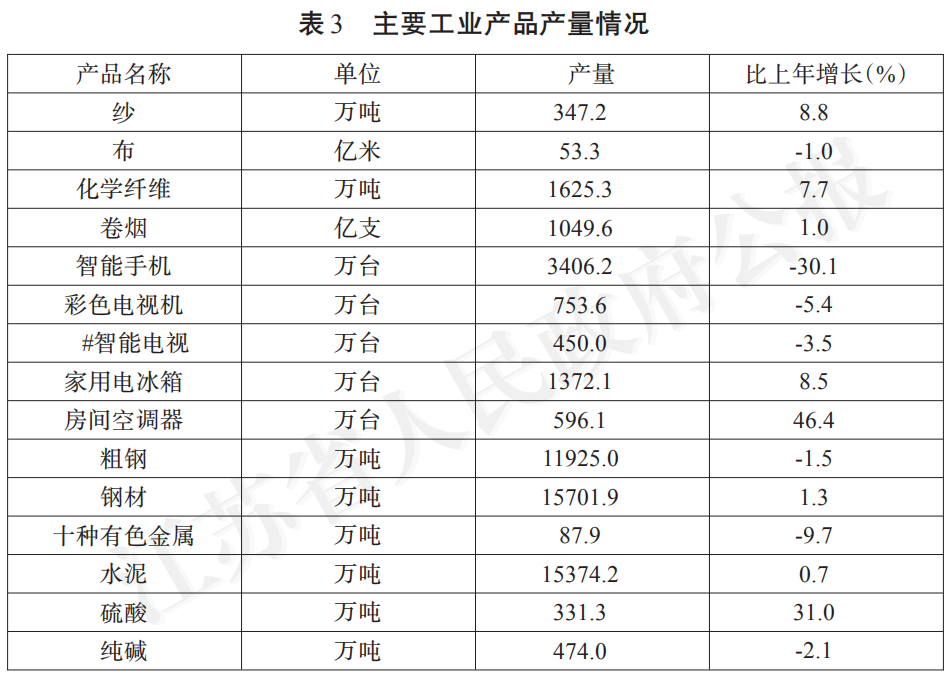

The profitability of industrial enterprises has improved. The total profits of industrial enterprises above designated size reached 935.81 billion yuan, an increase of 25.7% over the previous year. In terms of economic types, the profit of state-owned holding enterprises was 137.03 billion yuan, an increase of 37.7%; 670 million yuan for collective enterprises, an increase of 54.9%; Joint-stock enterprises reached 550.71 billion yuan, an increase of 30.4%; Foreign investors and Hong Kong, Macao and Taiwan businessmen invested 368.15 billion yuan, an increase of 19.9%; Private enterprises reached 336.12 billion yuan, an increase of 30.6%. In terms of categories, the profit of the mining industry was 1.89 billion yuan, an increase of 3.2% over the previous year; The manufacturing industry was 907.20 billion yuan, an increase of 30.5%; Electricity, heat, gas and water production and supply industries reached 26.73 billion yuan, down 43.6%. The operating income profit rate and cost profit rate of industrial enterprises above designated size were 6.2% and 6.7%, respectively, 0.2 and 0.3 percentage points higher than the previous year. The annual production and sales rate of industrial enterprises above designated size reached 98.2%.
The construction industry has developed steadily and healthily. The amount of construction contracts signed in the whole year was 6,144.30 billion yuan, an increase of 5.8% over the previous year; The total output value of the construction industry was 3,824.45 billion yuan, an increase of 8.5% over the previous year; The completed output value was 2,706.37 billion yuan, an increase of 6.2%, and the completion rate reached 70.8%. The labor productivity of the construction industry was 369,000 yuan/person, an increase of 2.1% over the previous year.
IV. Investment in fixed assets
The growth rate of investment has steadily increased. Annual investment in fixed assets increased by 5.8% over the previous year. Among them, state-owned and state-owned economy holding investment increased by 3.1%, and foreign investment and investment from Hong Kong, Macao and Taiwan businessmen increased by 7.2%. Private investment increased by 6.3%, accounting for 69.2% of the total investment. By type, project investment increased by 7.6%, and real estate development investment increased by 2.3%. The annual sales area of commercial housing was 165.518 million square meters, an increase of 7.3% over the previous year. Among them, the residential sales area was 143.615 million square meters, an increase of 3.7%.
The investment structure was continuously optimized. The annual investment in high-tech industries increased by 21.6% over the previous year, and the growth rate was 15.8 percentage points higher than the total investment, driving the total investment to increase by 3.5 percentage points. Among the major industries, the investment in medical equipment and instrument manufacturing, electronic and communication equipment manufacturing, pharmaceutical manufacturing, information services and other industries grew rapidly, with an increase of 25.6%, 21.5%, 14.6% and 15.7% respectively. Investment in manufacturing industry increased by 16.1%, which was 10.3 percentage points higher than the growth rate of total investment, driving the growth rate of total investment by 6 percentage points. Among the investment in service industry, investment in information transmission software and information technology service industry increased by 27.8%, investment in scientific research and technology service industry increased by 24.9%, and investment in health and social work increased by 18%.
V. Domestic trade
The consumer goods market recovered steadily. The total retail sales of consumer goods in the whole year was 4,270.26 billion yuan, an increase of 15.1% over the previous year. According to business statistics, the retail sales of urban consumer goods reached 3,785.02 billion yuan, up by 13.6%. The retail sales of rural consumer goods reached 485.24 billion yuan, an increase of 28.9%. Among the retail sales of commodities above designated size in the whole year, the sales of basic necessities increased steadily, and the daily necessities, clothing, shoes, hats, needles, textiles, cereals, oils and foodstuffs increased by 22.6%, 16.7% and 16.0% respectively. Upgraded consumer demand continued to be released, with sports and entertainment products, smart household appliances and audio-visual equipment, smart phones, gold and silver jewelry increasing by 39.8%, 35.2%, 25.9% and 22.4% respectively; Travel sales maintained a steady momentum, with oil, products and automobiles increasing by 26.6% and 9.9% respectively, among which new energy vehicles increased by 105.4%. The annual online retail sales of physical goods reached 952.7 billion yuan, up 5.2% over the previous year, accounting for 22.3% of the total retail sales of social consumer goods.
VI. Open economy
Foreign trade maintained rapid growth. The total import and export volume reached 5,213.06 billion yuan, up by 17.1% over the previous year. Among them, the export was 3,253.23 billion yuan, an increase of 18.6%; Imports reached 1,959.83 billion yuan, up by 14.8%. From the perspective of trade mode, the total import and export volume of general trade was 2,932.83 billion yuan, an increase of 23.3%; It accounts for 56.3% of the total import and export, exceeding the processing trade by 24.7 percentage points. From the perspective of export subjects, the export volume of state-owned enterprises, foreign-funded enterprises and private enterprises increased by 22.4%, 11.4% and 27.7% respectively. From the export market, exports to the United States, the European Union and Japan increased by 14.4%, 21.9% and 6.3% respectively, while exports to India, Russia and ASEAN increased by 38%, 38.2% and 15.7% respectively. From the perspective of export products, the export volume of electromechanical and high-tech products increased by 17.8% and 10.4% respectively. Exports to countries along the "Belt and Road" maintained rapid growth, with an export value of 892.49 billion yuan, an increase of 20.8%; It accounts for 27.4% of the province’s total exports and contributes 30.1% to the province’s export growth.
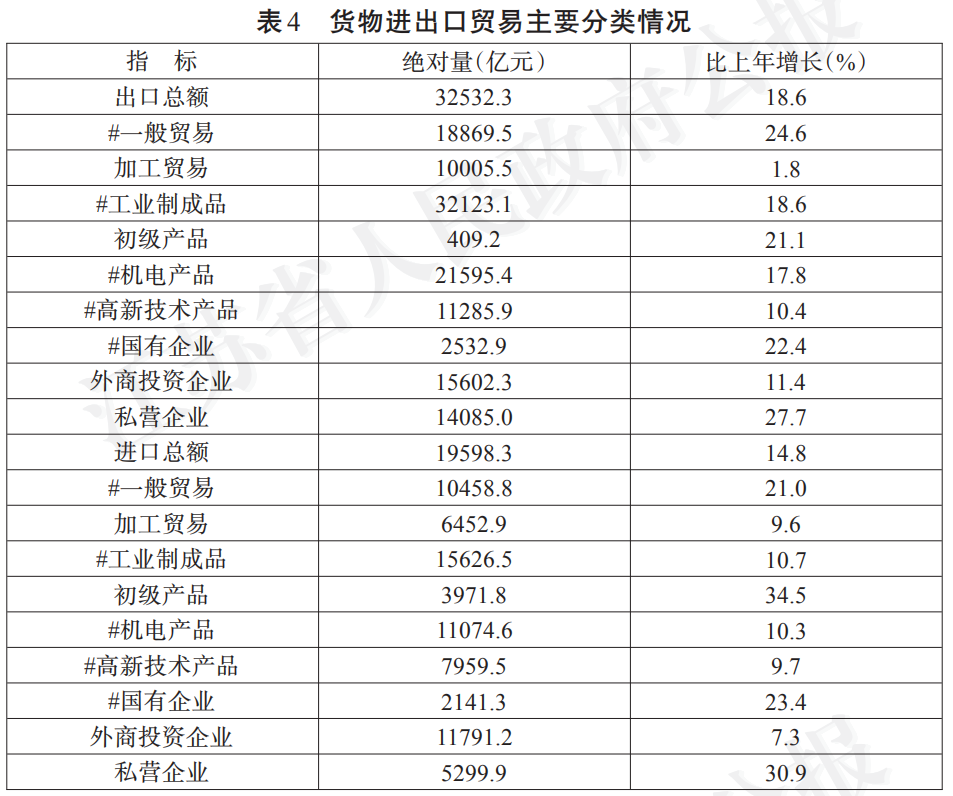

The utilization of foreign capital has increased steadily. In the whole year, 4,237 foreign-invested enterprises were newly established, an increase of 18.6% over the previous year; The actually used foreign capital was US$ 28.85 billion, up by 22.7%. In the whole year, 726 overseas investment projects were newly approved, with an agreed investment of US$ 6.68 billion from China. The contract value of newly signed foreign contracted projects was US$ 5.59 billion, and the turnover of newly signed foreign contracted projects was US$ 5.95 billion. Promote the construction of the "Belt and Road" intersection, and add 191 foreign investment projects along the "Belt and Road" throughout the year, with an agreed investment of US$ 1.59 billion from China.
VII. Transportation, Posts and Telecommunications and Tourism
The transportation industry is generally stable. The transportation volume of goods completed by five modes of transportation in the province, such as Tiegong Water and Air Traffic Control, increased by 6.5% compared with the previous year, and the turnover of goods increased by 7.8%; Passenger traffic decreased by 22.5%, and passenger turnover increased by 5.1%. The province’s airport aircraft took off and landed 437,000 times, down 1.8% from the previous year; The passenger throughput was 39.414 million passengers, an increase of 0.5%; The cargo and mail throughput was 653,000 tons, down 2.8%. The port throughput of the province was 3.21 billion tons, up by 8.2% over the previous year, of which the foreign trade cargo throughput was 590 million tons, up by 6.6%. The container throughput was 21.801 million TEUs, up by 15%. At the end of the year, the province’s highway mileage was 159,000 kilometers, an increase of 414 kilometers over the end of the previous year, of which the expressway mileage was 5,028 kilometers. The operating mileage of railways is 4,221.9 kilometers, of which the mileage of high-speed railways is 2,212 kilometers, an increase of 191 kilometers over the previous year; The extension length of the main railway line is 7591.7 kilometers, an increase of 366.3 kilometers over the previous year. At the end of the year, the number of civilian vehicles was 21.87 million, an increase of 7% over the end of last year, with a net increase of 1.426 million. At the end of the year, the number of private cars was 18.627 million, an increase of 6.6% over the end of the previous year, with a net increase of 1.148 million; Among them, the number of private cars was 12.535 million, an increase of 5.5% and a net increase of 905,000.
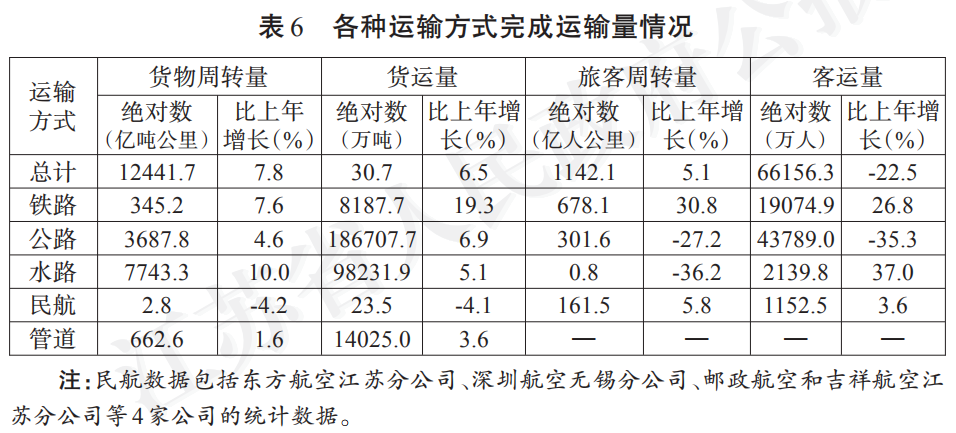
The postal telecommunications industry has developed rapidly. The total business volume of the postal and telecommunications industry in 2001 was 227.01 billion yuan, an increase of 25.9% over the previous year; The business income was 213.66 billion yuan, an increase of 9.6%. In terms of industries, the postal industry completed a total business of 97.27 billion yuan, an increase of 20%; The business income was 100.11 billion yuan, an increase of 8.9%. Among them, the express delivery industry completed 8.61 billion pieces of business, an increase of 23.4%. The total business volume of the telecommunications industry was 129.75 billion yuan, an increase of 30.8% over the previous year; The business income was 113.55 billion yuan, an increase of 10.3%. At the end of the year, there were 12.505 million fixed-line users, a decrease of 599,000 from the end of the previous year; At the end of the year, there were 101.795 million mobile phone users, with a net increase of 2.824 million; The telephone penetration rate reached 134.3 units per 100 people. At the end of the year, the total length of long-distance optical cable lines was 39,600 kilometers, a decrease of 856.4 kilometers compared with the end of the previous year; At the end of the year, there were 40.716 million Internet broadband access users, an increase of 8.4% over the end of the previous year, with a net increase of 3.148 million. The transmission traffic of mobile Internet was 146.1 trillion GB, an increase of 33.9%.
Tourism has recovered rapidly. In the whole year, it received 710 million domestic and foreign tourists, an increase of 49.6% over the previous year; The total tourism revenue was 1,167.27 billion yuan, an increase of 41.5%. Received 619,000 overnight visitors, down 19.7%. Among them, there were 398,000 foreigners, a decrease of 23%; There were 221,000 compatriots from Hong Kong, Macao and Taiwan, down by 12.9%. Foreign exchange income from tourism was $1.14 billion, down 31%. Domestic tourism has grown rapidly. Received 710 million domestic tourists, an increase of 49.7% over the previous year; Domestic tourism revenue reached 1,159.39 billion yuan, an increase of 42.5%.
Eight, finance, finance
Fiscal revenue exceeded one trillion yuan. In the whole year, the general public budget revenue was 1,001.52 billion yuan, an increase of 10.6% over the previous year; Among them, tax revenue was 817.13 billion yuan, an increase of 10.2%; Tax revenue accounted for 81.6% of the general public budget revenue, and continued to maintain a high level.
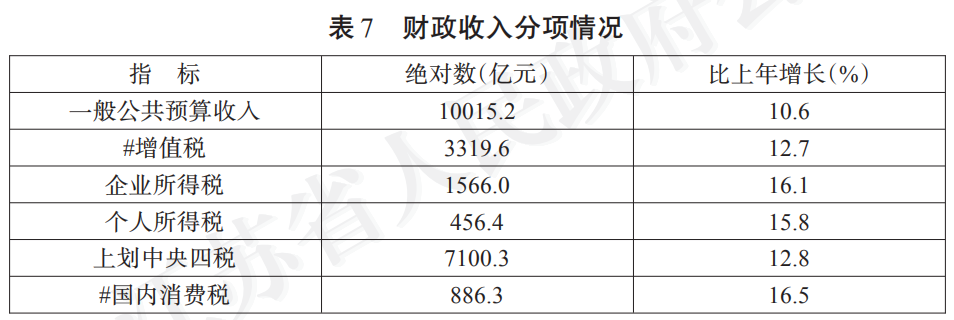
The expenditure structure continued to improve. The annual general public budget expenditure was 1,458.60 billion yuan, an increase of 6.6% over the previous year. Of the general public budget expenditure, education expenditure was 256.21 billion yuan, an increase of 6.5%; Public security expenditure was 90.84 billion yuan, up by 2.7%; Health expenditure was 118.27 billion yuan, an increase of 17.4%; Expenditure on social security and employment was 189.56 billion yuan, an increase of 6.5%; Expenditure on housing security was 77.78 billion yuan, up by 17.6%.
The scale of financial credit has expanded. At the end of the year, the balance of RMB deposits in financial institutions in the province was 18,943.31 billion yuan, an increase of 9.8% over the end of last year and 1,685.29 billion yuan over the beginning of the year. Among them, household deposits increased by 798.88 billion yuan, and non-financial enterprise deposits increased by 472.56 billion yuan. At the end of the year, the balance of RMB loans of financial institutions was 17,797.01 billion yuan, an increase of 15.2% over the end of the previous year and an increase of 2,344.68 billion yuan over the beginning of the year. Among them, medium and long-term loans increased by 1,762.38 billion yuan and short-term loans increased by 372.53 billion yuan.

The securities market developed rapidly. At the end of the year, there were 571 listed companies and 380 counseling enterprises in the province, and enterprises in the province raised 757.82 billion yuan in the capital market through issuance, rights issue, additional issuance and corporate bonds. The total share capital of listed companies in Jiangsu enterprises was 447.44 billion shares, up by 6.0% over the previous year. The total market value was 7,553.75 billion yuan, an increase of 20.3%. At the end of the year, there were 6 securities companies and 1035 securities business departments in the province. There are 9 futures brokerage companies and 193 business departments of futures brokerage companies; There are 3 securities investment consulting institutions. The annual securities transaction volume was 100.2 trillion yuan, up by 13.0% over the previous year. In the whole year, the agency transaction volume of futures operating institutions was 32.7 trillion yuan, an increase of 63.4% over the previous year.
The insurance industry grew steadily. The annual premium income was 405.11 billion yuan, an increase of 5.2% over the previous year. In terms of types, property insurance income was 100.22 billion yuan, an increase of 2.3%; Life insurance income was 234.50 billion yuan, up by 5.5%; Health insurance income was 60.96 billion yuan, an increase of 8.8%; Accidental injury insurance income was 9.44 billion yuan, an increase of 10.3%. The annual compensation expenditure was 125.48 billion yuan, an increase of 18.4% over the previous year. Among them, property insurance paid 62.58 billion yuan, an increase of 12.5%; Life insurance payment was 25.73 billion yuan, down by 8.7%; Health insurance paid 34.54 billion yuan, an increase of 74.4%; Accidental injury insurance paid 2.63 billion yuan, down 9.3%.
IX. Science, Technology and Education
The ability of scientific and technological innovation has been continuously enhanced. The number of patents granted in the province was 641,000, an increase of 28.4% over the previous year, including 69,000 invention patents, an increase of 49.7%; The number of PCT patent applications was 7,168, down by 25.4%. At the end of the year, the number of valid invention patents in the province was 349,000, an increase of 19.7% over the end of last year; The number of invention patents per 10,000 people was 41.2, an increase of 13.9%. The contribution rate of scientific and technological progress was 66.1%, an increase of 1 percentage point over the previous year. In the whole year, 83,000 technical contracts were signed, and the turnover of technical contracts reached 301.36 billion yuan, an increase of 29% over the previous year. There are 1075 creative spaces at or above the provincial level.
The development of high-tech industries has accelerated. Integrated implementation of 225 industrial foresight and key core technology research and development, major scientific and technological achievements transformation projects, breaking through a number of industrial technology bottlenecks. At that time, it was recognized that there were more than 12,000 national high-tech enterprises and 163 national enterprise R&D institutions, ranking among the top in the country. The province has built 172 national high-tech characteristic industrial bases.
Investment in scientific research has increased. The expenditure of research and experimental development (R&D) activities in the whole society accounts for 2.95% of the regional GDP, and there are 924,000 R&D personnel. The province has 118 academicians from China Academy of Sciences and China Academy of Engineering. Among various scientific research and technology development institutions, there are 446 independent research and development institutions of government departments. We will build 186 national and provincial key laboratories, 260 public service platforms for science and technology at or above the provincial level, 4,464 engineering technology research centers, 144 academician workstations and 2 nationally recognized technological innovation centers.
Education has developed in an all-round way. There are 168 colleges and universities (including independent colleges) in the province. General higher education has 652,000 students enrolled, 2.111 million students enrolled and 524,000 graduates. There are 95,000 graduate students enrolled, 272,000 students enrolled and 63,000 graduates. The number of students in secondary vocational education in the province is 641,000 (excluding technical schools). Special education schools enrolled 3,000 students and enrolled 20,000 students. There are 8,116 kindergartens in the province, an increase of 213 over the previous year; There were 2.525 million children in the park, 16,000 fewer than the previous year.
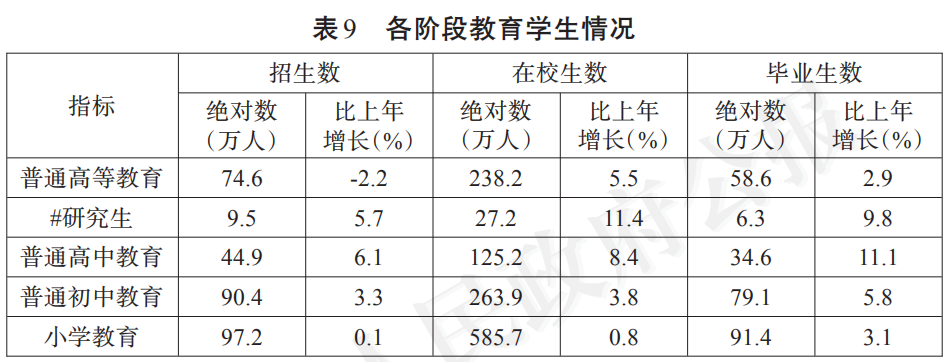
X. Culture, Health and Sports
The level of public cultural services has been continuously improved. The urban and rural public cultural service system has been continuously improved. There are 116 cultural centers and mass art galleries, 122 public libraries, 366 museums, 48 art galleries and 112 comprehensive archives in the province, and 3.413 million volumes of archives are open to the public. There are 4 radio stations, 4 TV stations, 10 radio and TV stations, and 21 medium and short-wave radio transmitting stations and relay stations, and the comprehensive population coverage of radio and television is 100%. There are 13.843 million cable TV users in the province. Production of 12 TV series with 433 episodes throughout the year; Review 36 films, including 31 story films, 3 documentary films and 2 animated films; 1.87 billion newspapers, 120 million periodicals and 730 million books were published.
Health undertakings have been steadily advanced. At the end of the year, there were 36,446 health institutions in the province. Among them, there are 2029 hospitals, 115 centers for disease control and prevention, and 118 maternal and child health care institutions. Various health institutions have 548,000 beds, of which hospitals have 429,000 beds. There are 688,000 health technicians, including 272,000 medical practitioners and assistant medical practitioners, 308,000 registered nurses, 9,000 health technicians from the Centers for Disease Control and Prevention, and 18,000 health technicians from maternal and child health care institutions.
Sports are developing vigorously. Mass sports and competitive sports, sports undertakings and sports industries have developed in a coordinated way, and Jiangsu athletes have achieved excellent results in the Tokyo Olympic Games and the 14th National Games. At the Tokyo Olympic Games, two people won two gold medals, six people won five silver medals and two people won two bronze medals, setting a world record and an Olympic record. Won 42 gold medals, 35 silver medals and 39 bronze medals in the 14th National Games, breaking 2 national records. In other world top-level competitions (except the Olympic Games), 7 people won 3 gold medals, 5 people won 3 silver medals and 3 people won 3 bronze medals.
XI. Environmental protection
The battle against pollution has achieved remarkable results. The quality of ecological environment has been the best since the century. The average annual concentration of PM2.5 in the province was 33 μ g/m3, down by 13.2% year-on-year, and the ratio of days with excellent air quality reached 82.4%, up by 1.8 percentage points year-on-year. For the first time, the province reached the second-class national air quality standard, achieving a historic breakthrough. In the national examination of water environment, the proportion of excellent section III was 87.1%, up by 3.8 percentage points year-on-year, and the inferior class V water was completely eliminated, which exceeded the national assessment task. Taihu Lake has been treated for 14 consecutive years to achieve "two guarantees" of safe drinking water and no large-scale flooding. The excellent proportion of seawater in coastal waters increased significantly year-on-year, and the excellent proportion of seawater in coastal waters in the province was 87.4%, up 41.1 percentage points year-on-year; The proportion of inferior four types of seawater was 17%, a year-on-year decrease of 7.9 percentage points. Detailed investigation of soil pollution was completed. The protection and restoration of the ecological environment of the Yangtze River has been solidly promoted, and the strategic orientation of "jointly protecting and not developing" has been firmly grasped, and the results of shoreline improvement along the Yangtze River have been consolidated and improved. The water quality of Jiangsu section of the main stream of the Yangtze River has remained Class II, and the proportion of natural coastline has increased to 73.2%.
The urban and rural environment was further optimized. The province’s forest coverage rate reached 24%, the number of national demonstration zones for ecological civilization construction increased to 27, and the number of rural villages with provincial characteristics increased to 446, and 9 national ecological garden cities were built, ranking first in the country. Vigorously promote the transformation and upgrading of the chemical, steel, coal and electricity industry and optimize the layout, and close 354 chemical production enterprises that have withdrawn from low-end backward and environmentally sensitive areas.
XII. Population, People’s Life and Social Security
The total population keeps growing. At the end of the year, the resident population of the province was 85.054 million, an increase of 281,000, or 0.3%. Among the permanent residents, there are 43.162 million males and 41.892 million females. There are 12.494 million people aged 0-14, 58.064 million people aged 15-64, and 14.496 million people aged 65 and above. The annual birth rate was 5.7‰, down 1.0 thousandths over the previous year; The population mortality rate was 6.8‰, up by 0.3 per thousand points over the previous year; The natural population growth rate was -1.1‰, down by 1.3 thousandths over the previous year. The pace of new urbanization was accelerated. At the end of the year, the urbanization rate of permanent residents reached 73.94%, an increase of 0.5 percentage points over the end of last year.
Residents’ income grew steadily. According to the household survey of urban-rural integration, the per capita disposable income of residents in the province was 47,498 yuan, an increase of 9.5% over the previous year. Among them, wage income was 26,721 yuan, an increase of 8.4%; The net operating income was 6,215 yuan, an increase of 9.0%; The net income of property was 5,316 yuan, an increase of 12.2%; The net transfer income was 9247 yuan, an increase of 11.5%. According to the place of permanent residence, the per capita disposable income of urban residents was 57,743 yuan, an increase of 8.7%; The per capita disposable income of rural residents was 26,791 yuan, up by 10.7%. The income gap between urban and rural residents has further narrowed, and the income ratio between urban and rural residents has narrowed from 2.19:1 in the previous year to 2.16:1. The per capita consumption expenditure of residents in the province was 31,451 yuan, an increase of 19.9% over the previous year. According to the place of permanent residence, the per capita consumption expenditure of urban residents was 36,558 yuan, an increase of 18.4%; The per capita consumption expenditure of rural residents was 21,130 yuan, an increase of 24.1%.
The social security system is more perfect. The per capita basic pension for retirees has increased by 4.5%, unemployment insurance has been further expanded and raised, basic medical insurance has been fully realized at the municipal level, and the basic livelihood of people in need has been better guaranteed. The number of people participating in urban and rural basic old-age pension, unemployment insurance and work-related injury insurance reached 59.64 million, 19.67 million and 23.407 million respectively, and the number of people receiving unemployment insurance was 292,000, down 12.1% from the end of last year. The number of people who participated in the basic medical insurance for urban and rural residents was 48.178 million, and the number of people who participated in the basic medical insurance for employees was 32.46 million. The participation rate of urban and rural basic medical insurance reached 98.5%, an increase of 0.5 percentage points over the same period of last year.
Social services are improving day by day. At the end of the year, there were 3,639 social service institutions providing accommodation in the province, including 2,494 institutions for the aged and 44 institutions for children. There are 455,000 social service beds, including 440,000 beds for the aged and 0.4 million beds for children. By the end of the year, there were 2,971 community service centers and 13,000 community service stations.
Note:
[1] The data used in this bulletin are express numbers.
[2] The growth rate of regional GDP, industrial added value above designated size and its classified projects is calculated at comparable prices, which is the actual growth rate; Other indicators, unless otherwise specified, are calculated at current prices and are nominal growth rates.
[3] The proportion of expenditure on research and experimental development (R&D) activities in regional GDP is estimated.
[4] Due to rounding of some data, the total is not equal to the sub-total.
[5] Some index data are not comparable to the previous year due to the adjustment of statistical caliber.
Browse and download the PDF version of the bulletin: Statistical Bulletin on National Economic and Social Development of Jiangsu Province in 2021. pdf
Statistical Bulletin on National Economic and Social Development of Jiangsu Province in 2021. pdf


